Chiffon cakes are one of the classic and elegant desserts that are great for any occasion. Here are my tips and techniques for making the perfect chiffon cake that is light, airy, tall, and springy. Troubleshooting included!
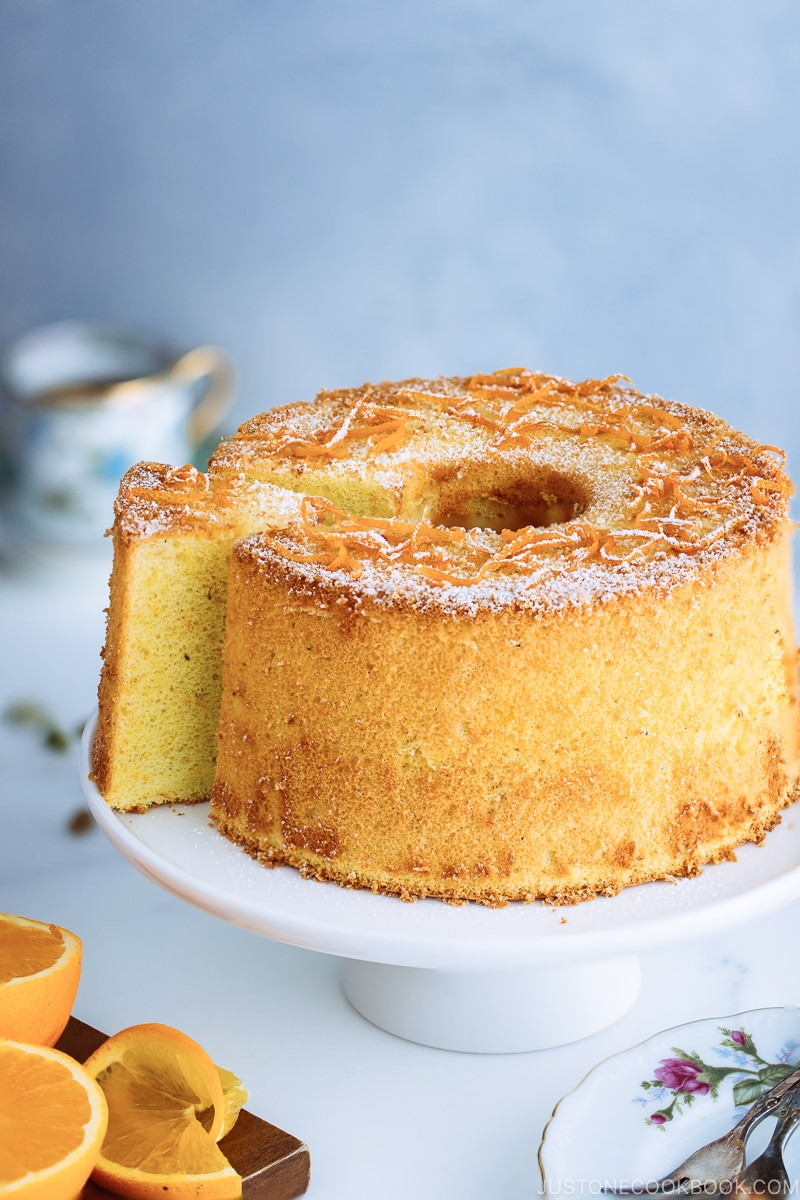
In this tutorial guide, I’ll show you the Japanese techniques on how to make a perfectly airy chiffon cake. The Japanese chiffon cakes are also a lot less sweet than the Western-style version, which most people would appreciate.
In addition to all the tips and FAQs, you’ll find my most popular chiffon cake recipes below, such as Earl Grey Chiffon Cake, Chocolate Chiffon Cake, and Matcha Chiffon Cake. I hope you enjoy making them!
Table of Contents
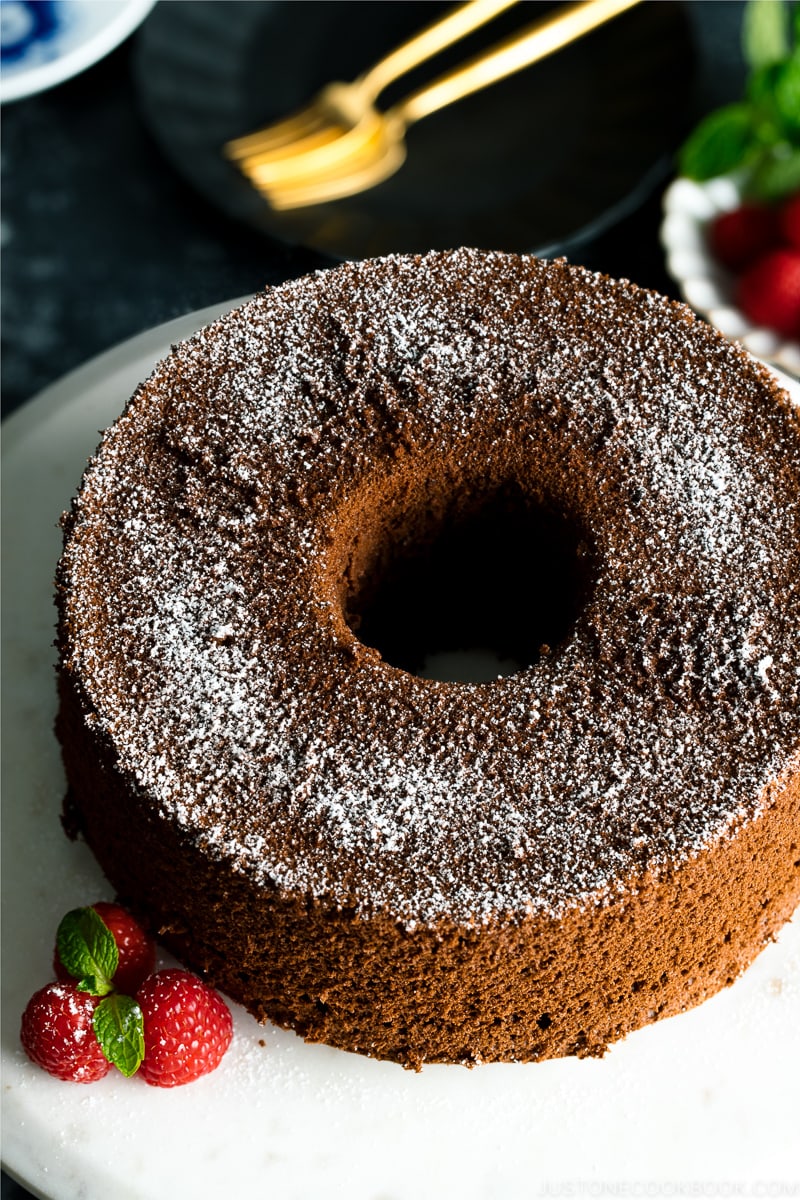
What is Chiffon Cake?
It is pronounced as SHE-fon cake. Chiffon cake is a light cake with a spongy texture made with simple ingredients such as oil, eggs, sugar, flour, and flavorings.
Unlike other types of sponge cakes that use chemical/artificial leavener such as baking soda and baking powder, chiffon cakes are leavened mostly from the meringue (stiffly beaten egg whites). They are baked in a tall pan at least four inches deep and must be cooled upside down to retain their height.
Is Chiffon Cake The Same as Angel Food Cake?
You might be more familiar with angel food cakes as they are commonly sold in grocery stores. The only difference between these two cakes is that angel food cake uses no egg yolks and no fat, but chiffon cakes include both whites and yolks.
How about Sponge Cake? Is There a Difference Between Chiffon Cake and Sponge Cake?
You can say that chiffon cake has the in-between texture of a sponge cake and a butter cake. It is lighter and airier when compared to a sponge cake. The base batter for both chiffon cake and sponge cake is made of separated, whipped egg whites and yolks. However, chiffon cake uses both baking powder and oil, while sponge cake doesn’t contain baking powder.
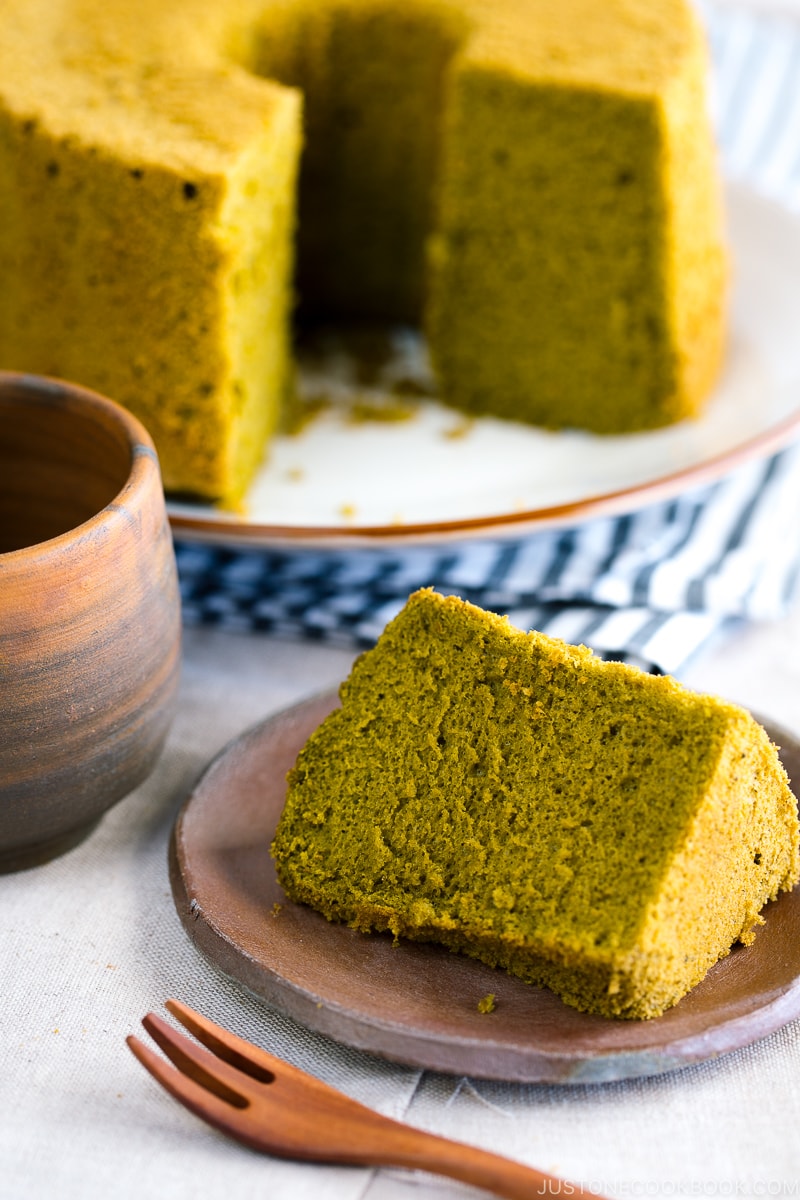
What Makes a Perfect Chiffon Cake and How to Achieve It?
Here are the characteristics of a perfect chiffon cake:
- It rises tall and straight to the top of the chiffon cake pan without caving into itself.
- No big holes or air pockets all around
- The texture of the sponge is light, fine, airy, fluffy, and bouncy.
- The sponge is very moist, and usually not overly sweet (especially if you are making a Japanese chiffon cake recipe).
In order to make a perfect chiffon cake, there are a few important factors. So let’s go over them.
1. Use the right chiffon cake pan
Make sure you use the right chiffon cake pan. The best types are the aluminum pan with a removable base. Make sure the pan is NOT non-stick. Do not grease the mold because the cake needs to cling to the sides and center of the pan for support as it rises. Otherwise, it will collapse. You can buy a 7-inch round angel cake pan with a removable base on Amazon or a 17-cm aluminum Japanese chiffon cake pan on Nihon Ichiban or Amazon.
2. Make the perfect meringue (beaten egg whites)
This is the most important factor, so I’ll cover this topic in a separate section below.
3. Mix in thoroughly with the whisk
I used to use a silicone spatula to fold beaten egg whites into the egg yolk mixture so that you won’t deflate the egg whites, which would result in a dry and dense cake. However, I have read several instructions and youtube videos that a balloon whisk is actually a better choice to incorporate egg whites into the batter. After a few trials, I am convinced that the whisk is the best way to fold in egg whites.
When you fold in egg whites, you might be afraid of breaking the air bubbles and may not mix the batter thoroughly. I felt the same way and always thought I mixed enough. However, when the egg whites are not mixed in with the mixture thoroughly, they would end up separated in the oven. As a result, it creates big air pockets inside the batter while being baked.
Fold carefully and slowly so you would not deflate the egg whites. Fold in one-third of the egg whites first to lighten the batter, and then fold in another 1/3. Then transfer the mixed batter into the egg whites to fold in the rest.
4. Remove air pockets
It’s important to remove air pockets before baking. When you pour the batter into the pan, make sure to pour it from 6-8 inches high at just one spot to prevent air bubbles from forming. Then, while holding the removable base in place, gently tap the cake pan on the work surface to release any air pockets in the batter. Lastly, run a wooden skewer through the batter to release any remaining air pockets.
5. Let cool upside down
The cake must be cooled upside down in its pan so that it stretches downward instead of collapsing. Stick the cake pan on a tall heavy bottle and let cool for 3-4 hours before removing the cake pan. If you use an angel food cake pan, invert the cake pan on a cooling rack.
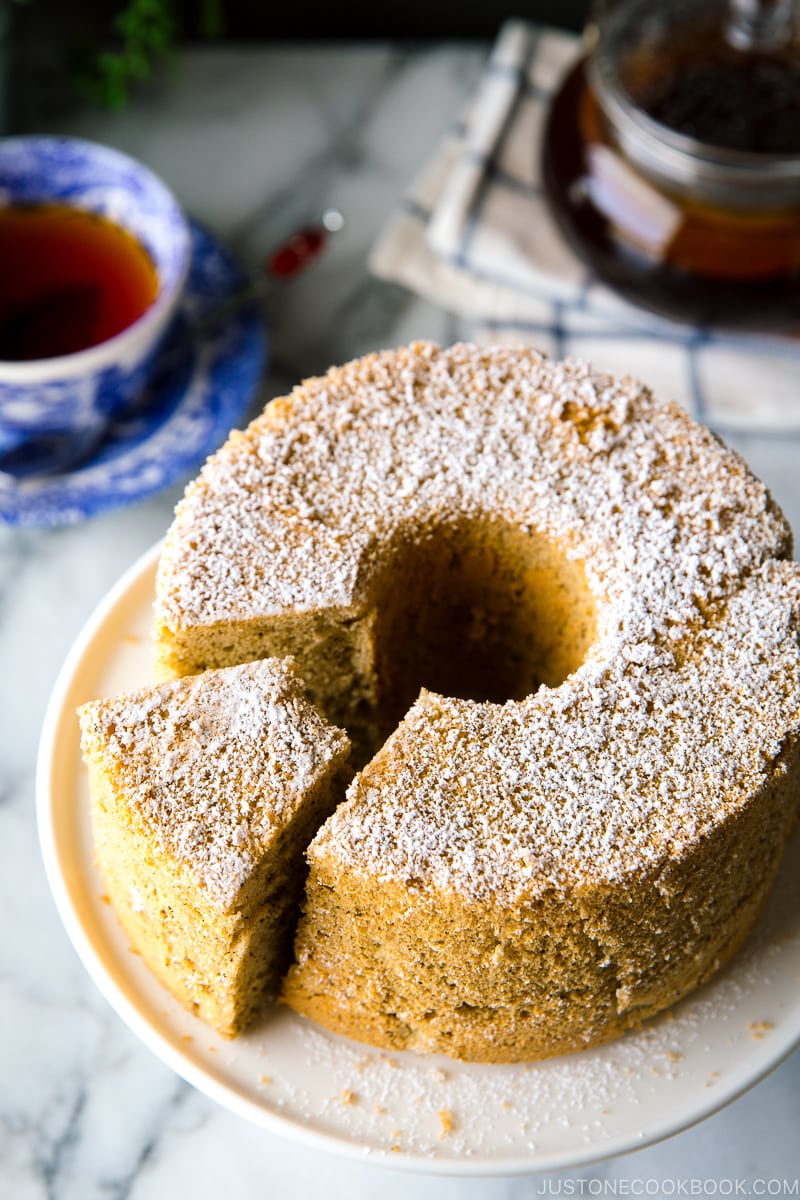
2 Tips to Make Perfect Meringue (Beaten Egg Whites)
The key to a successful chiffon cake is the meringue (the beaten egg whites). There is no clear and easy way to show how much beating is enough, except for your own trials and errors. I could only give you a few tips that will help you succeed. Before anything, make sure your beaters and mixing bowl are clean and dry.
Tip #1: Chill egg whites (What?!)
I know, it’s the total opposite of what you learned from American recipes. I’ve seen most of the American recipes use room-temperature egg whites to make the meringue. However, almost all (99%) Japanese chiffon cake recipes require cold, well-refrigerated, or sometimes half-frozen egg whites, to make meringue without cream of tartar. Chilled egg whites will make very fine and smooth meringue with small and strong air bubbles inside. They remain strong even in the oven and help the batter rise higher and fluffier. If you are not from the US, which method do you use?
Tip #2: Whisk until stiff peak with a tip that folds over
There is always discussion on how much you should beat the egg whites. From my experience, it’s best to stop the mixer when you’re close to finishing to check the condition of the peaks.
When you lift the whisk, the egg whites in the bowl or on the whisk should be firm enough to go straight up and hold a stiff peak, but just the very tip may fold over a little, like taking a bow. The meringue should have a slightly glossy texture, too.
Then, switch from the hand-held electric mixer (or stand mixer) to a balloon whisk, and thoroughly mix the sides and center of egg whites a few times to get to the same consistency throughout.
If you overbeat the meringue, it will become very stiff and grainy and won’t incorporate into the batter at all.
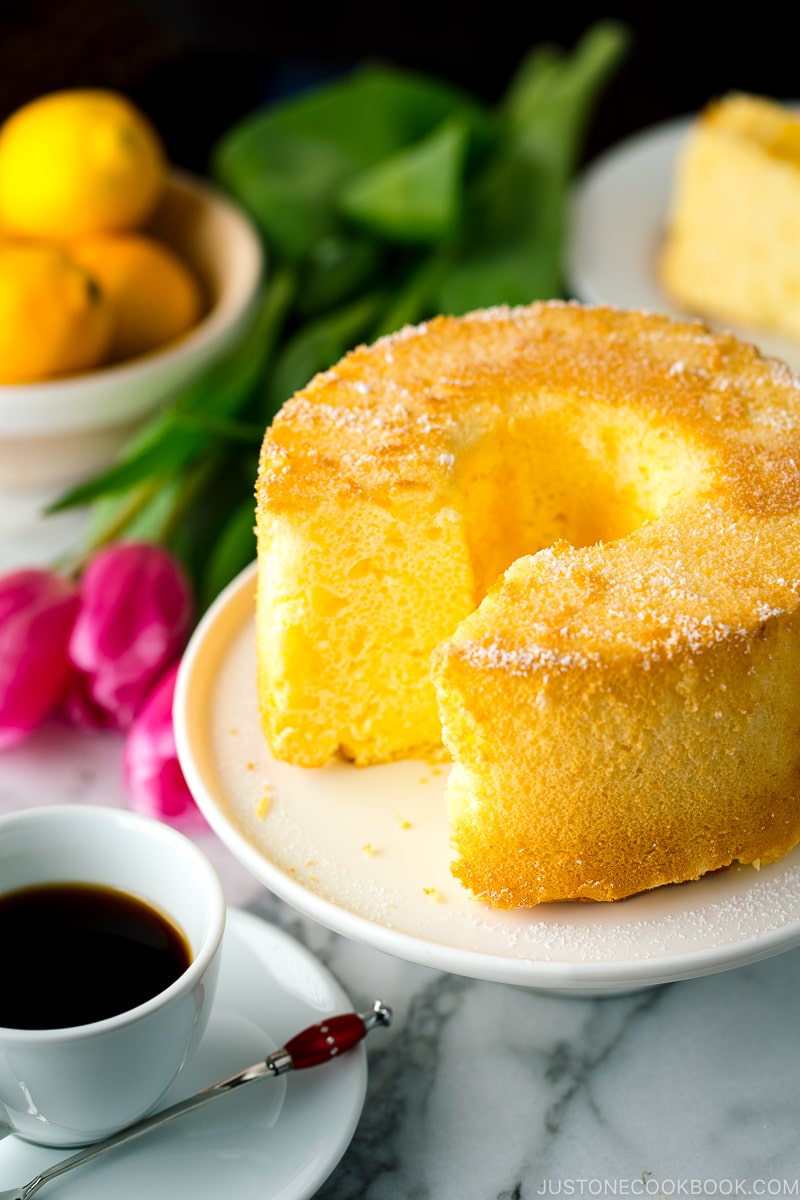
Adjust Ingredients for Different Sizes of Chiffon Cake Pan
Since a 17-cm chiffon cake pan is the most common size for chiffon cakes in Japan, I usually bake with a 17-cm Japanese chiffon cake pan. It’s a decent-size cake by Japanese standards, but it will look smaller next to typical American cakes.
*Below I include the measurements for different-size pans for your reference.
15-cm (6-inch) chiffon cake pan
- 2 large eggs (100 g without shell)
- 60 g (5 Tbsp) granulated sugar
- 30 ml (2 Tbsp) vegetable oil
- 40 ml (2 Tbsp and ¾ tsp) water/milk/citrus juice (such lemon juice)
- 50 g (¼ cup and add 4 tsp) cake flour (Make sure to measure correctly; See my tutorial video.)
- 3 g (¾ tsp) baking powder
- vanilla extract
Bake at 340 ºF (170 ºC) for 25-30 minutes.
17-cm (7-inch) chiffon cake pan (BASIC)
- 3 large eggs (150 g without shell)
- 85 g (measure ½ cup and remove 1 Tbsp) granulated sugar
- 40 ml (measure 3 Tbsp and remove 1 tsp) vegetable oil
- 60 ml (¼ cup) water/milk/citrus juice
- 75 g (⅔ cup and remove 2 tsp) cake flour (Make sure to measure correctly; See my tutorial video.)
- 4 g (1 tsp) baking powder
- 1 tsp vanilla extract
Bake at 340 ºF (170 ºC) for 30-35 minutes.
20-cm (8-inch) chiffon cake pan
- 5 large eggs (250 g without shell)
- 130 g (⅔ cup) granulated sugar
- 60 ml (¼ cup) vegetable oil
- 95 ml (measure ⅓ cup and add 1 ½ Tbsp) water/milk/citrus juice
- 120 g (1 cup) cake flour (Make sure to measure correctly; See my tutorial video.)
- 6 g (1 ¼ tsp) baking powder
- 1 ½ tsp vanilla extract
Bake at 340 ºF (170 ºC) for 35-40 minutes.
22-cm (8.5-inch) chiffon cake pan
- 6 large eggs (300 g without shell)
- 170 g (measure 1 cup and remove 2 Tbsp) granulated sugar
- 80 ml (6 Tbsp) vegetable oil
- 120 ml (½ cup) water/milk/citrus juice
- 150 g (1 ¼ cup) cake flour (Make sure to measure correctly; See my tutorial video.)
- 8 g (2 tsp) baking powder
- 2 tsp vanilla extract
Bake at 340 ºF (170 ºC) for 40-45 minutes.
23-cm (9-inch) chiffon cake pan
- 7 large eggs (350 g without shell)
- 190 g (measure 1 cup and remove 1 Tbsp) granulated sugar
- 90 ml (measure ⅓ cup and add 1 Tbsp) vegetable oil
- 135 ml (measure ½ cup and add 1 Tbsp) water/milk/citrus juice
- 170 g (measure 1 ⅓ cup and add 1 Tbsp) cake flour (Make sure to measure correctly; See my tutorial video.)
- 9 g (2 ¼ tsp) baking powder
- 2 ½ tsp vanilla extract
Bake at 340 ºF (170 ºC) for 45-50 minutes.
25-cm (10-inch) chiffon cake pan
- 8 large eggs (400 g without shell)
- 230 g (measure 1 cup and add 2 Tbsp) granulated sugar
- 110 ml (measure ½ cup and remove 2 tsp) vegetable oil
- 170 ml (measure ⅔ cup and add 2 tsp) water/milk/citrus juice
- 210 g (1 ¾ cup) cake flour (Make sure to measure correctly; See my tutorial video.)
- 11 g (2 ⅔ tsp) baking powder
- 2 ¾ tsp vanilla extract
Bake at 340 ºF (170 ºC) for 50-55 minutes.
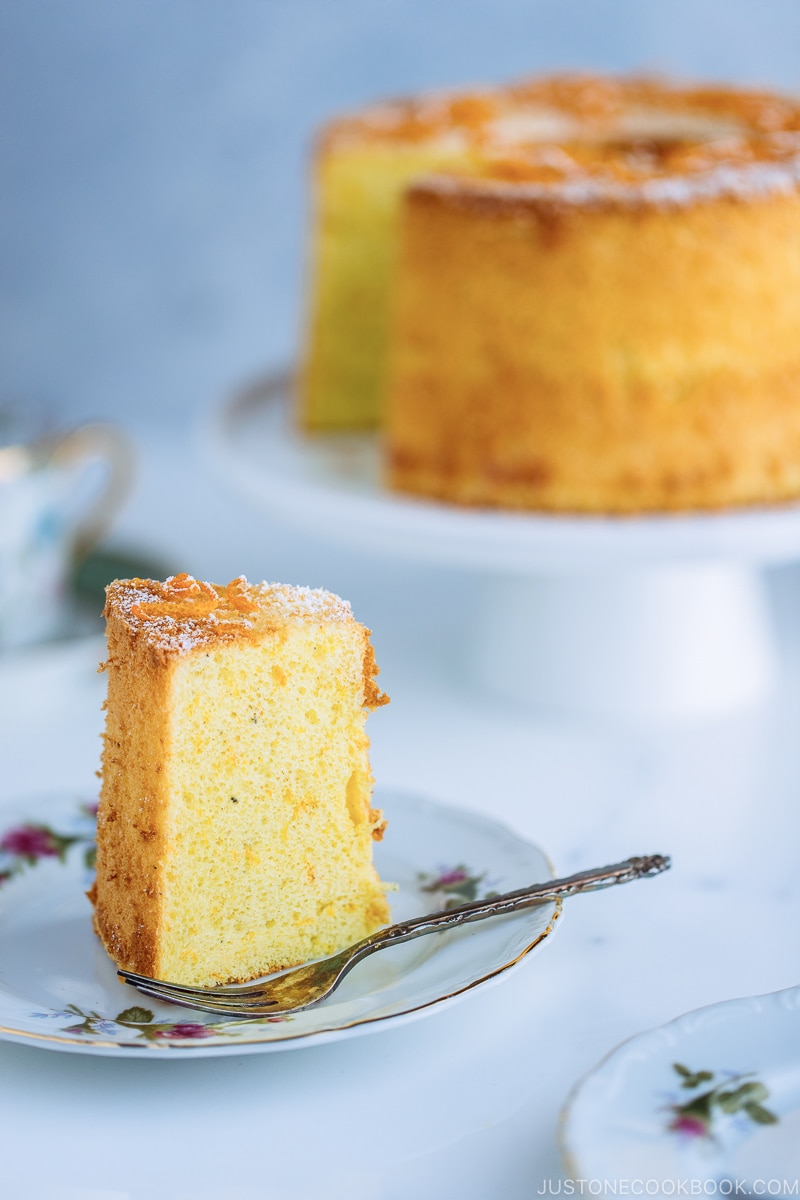
What Went Wrong? Troubleshooting Chiffon Cakes
1. My chiffon cake didn’t rise properly. My chiffon cake sank/deflated after I took it out of the oven.
- Get a chiffon cake pan: Please use an aluminum, 2-piece tube pan. You cannot use a non-stick pan to make chiffon cake as the wall is too slippery for the batter to cling to the sides and center of the chiffon cake pan in order to rise higher.
- Do not grease: For the same reason, you do not need to grease the cake pan.
- Invert the cake pan to let it cool: If you didn’t use a chiffon cake pan, you can’t do this step. It’s very important to invert the chiffon cake pan while letting it cool so the cake will not collapse and it will continue to stay tall with the help of gravity.
- Beat egg whites correctly: Under-beating egg whites will cause the cake structure to collapse, while over-beating can cause the mixture to break down when you fold it into the batter, creating a heavy batter. Therefore, always keep an eye out for the egg whites as they thicken. A safe way to do this is to whip your egg whites on medium speed. And it’s ok to stop frequently to check as you get close to the stiff peak stage.
- Check oven temperature: When the oven temperature is too low, the cake will not rise to its optimum height. It’s also possible that your oven setting doesn’t display the actual oven temperature. Get an oven thermometer to place it in the oven and test the actual oven temperature at 4 corners and the center. My oven has some hot spots in one corner so I know I need to avoid placing my cake there.
- Increase baking time: If you did everything right, maybe the baking time was not enough.
2. My cake got burnt on the top.
- Use aluminum foil: Your oven may be a bit too small for this cake pan. You need at least some space between the cake pan top and the oven. To fix this problem, you can cover the cake with aluminum foil over the top to prevent further browning once the cake reaches a nice golden color.
3. My cake has big holes (air pockets).
- Mix thoroughly: When you don’t fold the egg whites and batter thoroughly, the cake batter is not consistent. The meringue parts have too many air bubbles than the other parts, which results in large pockets and other parts of the batter cannot sustain the structure. Make sure you mix everything thoroughly without destroying the bubbles.
- Beat egg whites correctly: When egg whites are under-beaten, the small air bubbles cannot sustain as the temperature goes up. As a result, small air bubbles turn into one bigger hole.
- Prevent air pockets: The air pockets may be created when you pour the batter into the chiffon cake pan. Make sure to pour the cake batter all at once in one location. Also, run the wooden skewer in the batter a few times and gently tap the chiffon cake pan against the kitchen counter to get rid of large air bubbles that are trapped in the cake batter.
4. My cake has white streaks.
- Mix thoroughly: Those white streaks are meringue (egg whites). It happened when you didn’t incorporate meringue into the batter thoroughly, so the egg whites appeared as white streaks.
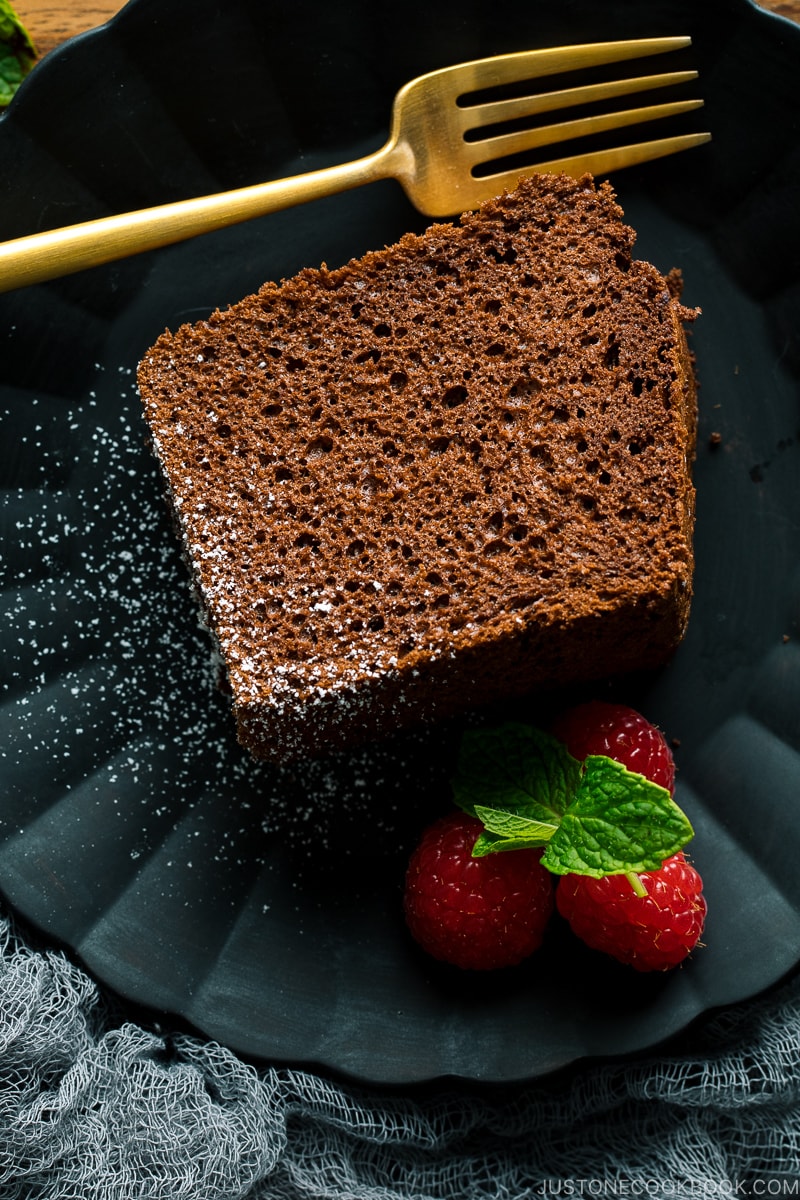
FAQs
Q: Can I use all-purpose flour instead of cake flour?
A: Japanese chiffon cake recipes always use cake flour. It is the reason why they are airy, fluffy, and soft. All-purpose flour has a higher protein content, which develops more gluten and results in a tougher cake. You would see the difference immediately.
The substitution or the easiest workaround for cake flour is to mix all-purpose flour with cornstarch. To make 1 cup of cake flour, simply take out 2 Tbsp from 1 cup of all-purpose flour and replace it with 2 Tbsp cornstarch. However, in my opinion, store-bought cake flour would give a better result as it has been sifted finely with the machine.
Q: Do we need to add baking powder?
A: In general, baking powder is not necessary as chiffon cake relies on egg whites to rise. Baking powder is just a backup. However, a chiffon cake recipe includes oil and egg yolks (fats), and baking powder to counteract and help the cake rise.
Q: Can I use melted butter instead of vegetable oil?
A: No, to get a light, airy, soft texture, it has to be vegetable oil or canola oil. Please don’t substitute it with butter.
Q: Can I bake it in a regular cake pan or bundt pan?
A: I highly recommend getting a tubed aluminum pan that allows the cake to rise taller. Avoid a non-stick pan and never grease the pan because the cake will not be able to cling and rise as high. If your chiffon cake pan is not the same size as mine, I always recommend doubling the recipe (instead of trying to divide an egg by weight). Use the leftover batter to make a small cake in a regular ramekin or smaller cake pan (it won’t be a proper chiffon cake though).
Q: When does the cake taste best?
A: It’s best half-day to a whole day after baking.
Q: How long does the cake last? Can I freeze chiffon cake?
A: Wrap the cake in plastic wrap and keep it in a cool, dark place for about 2-3 days. Depending on the ingredients or climate you live in, it might be better to keep it in the refrigerator for 3-4 days. Be sure to let the cake come to room temperature before serving, or it may seem dry and dense.
You can also wrap the individual piece or the whole cake in a layer of plastic wrap and another layer of tin foil before storing in the freezer. Note that some flavors will be lost. Defrost naturally and enjoy.
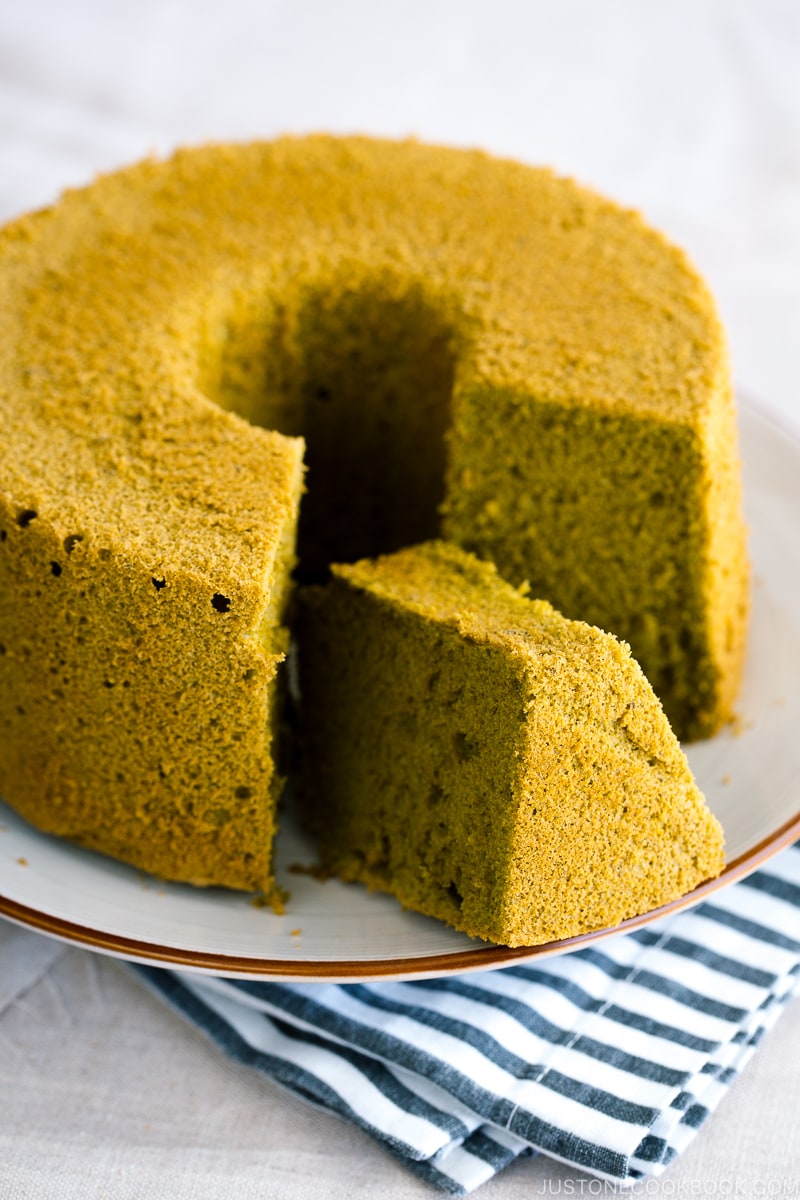
Our Most Popular Chiffon Cake Recipes
Each of the recipes below includes step-by-step images (and some with videos) which provide visual guidance:
- Chocolate Chiffon Cake – This is an all-star dessert! You’ll love the rich chocolate flavor and super moist texture.
- Earl Grey Chiffon Cake – So lovely for afternoon tea.
- Matcha Green Tea Chiffon Cake – The earthy, vanilla-like matcha green tea flavor is unmistakable.
- Meyer Lemon Chiffon Cake – Who would resist the refreshing aroma of the Meyer lemons in a cake?!
- Orange Chiffon Cake – This one has a warm, citrusy aroma from the orange zest and a hint of cardamom. Get ready to impress!
- Have you tried any fun flavors you would like me to share next? I’d love to hear from you!
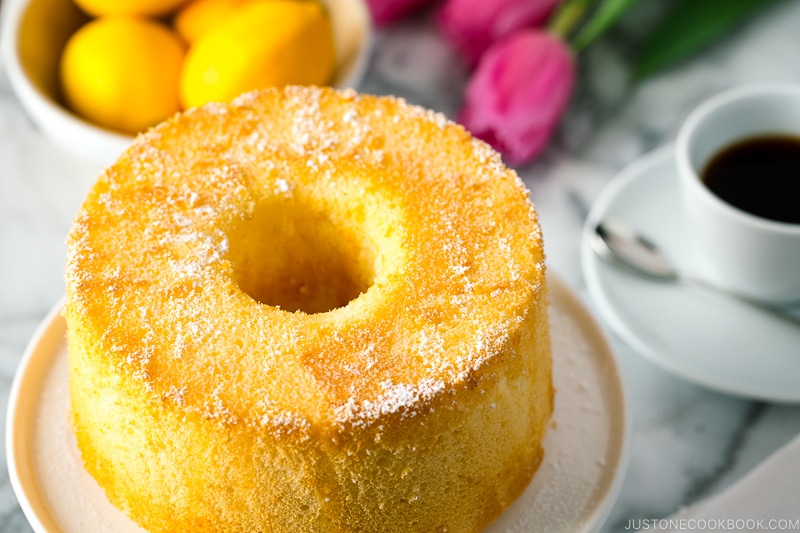
You can serve the chiffon cakes on their own or with fresh whipped cream (or frosting but go easy with it) and fresh-cut fruits.
I hope this tutorial guide will help you with your chiffon cake adventures. If you baked a chiffon cake and you’re still having trouble, please ask in the comments below. I’ll be happy to help.
Wish to learn more about Japanese cooking? Sign up for our free newsletter to receive cooking tips & recipe updates! And stay in touch with me on Facebook, Pinterest, YouTube, and Instagram.










I made this JOC base recipe (vanilla flavour only) with the 7 egg (23cm) recipe, but baked in Asai Shoten 20cm tall chiffon mold. I didn’t know there was also a tall 20cm when ordering the other sizes, so bought separately.
The tall 20cm is about 139mm tall (I think the regular 20cm height is 100mm?), and can apparently bake a double 17cm tall recipe. I noticed the regular 3 large egg recipe (for regular size 17cm) is a little small for 17cm tall, so rather than trying the 6 egg recipe, I decided to try the 7 egg recipe. The only other difference from JOC guide is I baked at about 355°F for about 50min.
I made chiffon sandwiches with whipped cream and strawberry, they were very delicious!
Once I have a chance to try the 10cm tall chiffon mold and a few more recipe attempts, I’ll try to make a summary post in case it will be helpful for others who may purchase the tall chiffon molds.
Hello there, T. J! Wow! What a stunning result! Thank you very much for testing several sizes and sharing the results with everyone!
We appreciate your generous support and contributions. Happy baking!🫶🏻😍
Im sorry for 4 eggs😅
Hello, Narjed. Thank you for trying Nami’s recipe.
You may double the two-egg recipe to make four eggs.🤗 We hope this helps!
Hi.thank you for your life saving recipe😁 can you please tell me how i can change the recipe for 3 eggs?
Hello! I don’t have a chiffon cake pan and would like to adapt the recipe for a regular pan. Which recipe would you recommend to fit my pan, which has dimensions of 18 × 10 cm (round)?
Hi, Maycon! Thank you for trying Nami’s recipe.
Your round cake pan holds around 10 cups, so the 8.5 or 9-inch recipe would be good.
However, a chiffon cake pan is highly recommended for making a beautiful tall chiffon cake.
We hope this helped!
Hi JOC team, wondering if anyone has experience adapting the JOC recipes to the “tall” Asai Shoten 浅谷商店 chiffon pans? I did a comment search and only could find a comment from Nami about where to find the standard height Asai Shoten 17cm pan (I believe the “tall” ones are 20mm taller). I have the 17, 15, 12, & 10cm “tall” chiffon pans on the way from Japan. I know I can make the standard size recipes and won’t risk ”mushrooming”, but may be interesting to get the full size chiffon. I’ll also see what the included recipes call for in terms of eggs, and perhaps see what the closest JOC recipe is
Hi T J! Thank you so much for reading Nami’s post!
We haven’t tried Asai Shoten’s tall chiffon cake pan, but their website says you can use a 17cm recipe and bake it successfully. If you want a full-sized Chiffon Cake like the one from the café, you must increase the ingredients by 120%.
We hope this helped! Please let us know how it goes if you attempt it!🤗
Hi Naomi,
Thank you for the information, I will definitely let JOC know how it goes once I have a chance to use them.
The package arrived today and I’ve noted that that included basic recipe for the “tall” pans are essentially the same amount of ingredients such as sugar, egg (adjusted for size since they seem to reference M eggs instead of L eggs), oil, flour, etc. … so I can use the JOC 17cm recipe in the article above, and it looks like the 15cm recipe matches the “tall” 14cm (I should have written 14cm instead of 15cm in my initial post).
Also, the 17cm “tall” recipes can make 2 “tall” 12cm chiffon, and the 14cm “tall” can make 2 “tall” 10cm chiffon, so I ordered an extra 12cm and 10cm (only 1 of each in picture). Clockwise from top-left: 17cm, 14cm, 10cm, 12cm “tall” chiffon cake pans… the 10cm is cute! ♪
Hi T J! Thank you very much for sharing the valuable information and photo of your adorable chiffon cake pans with us! Yes! The tall ones are gorgeous, and I’d want to try them one day.😆
Hello! How do I modify your 9″ chiffon cake recipe to make the earl grey chiffon cake recipe? Is the 135ml of liquid using strong brewed tea? How much Earl Grey leaves should I steep?
Hi Sandra! Thank you so much for reading Nami’s post.
To steep the tea, steep 10 g of Earl Grey loose tea leaves in 180 ml of hot water, then use 135 ml.
We hope this works well for you.
https://www.justonecookbook.com/earl-grey-chiffon-cake/
Can I bake it in a fan forced oven?
Hi Sue, Thank you so much for taking the time to read Nami’s post.
We recommend lowering the baking temperature by 25ºF (15ºC) and baking according to the recipe.
We hope this was helpful!
Hello! I really want to ask what happened to the Cream Cheese Chiffon cake? I wanted to make it again but I could not find it anywhere!
Hi Ren! Thank you for trying Nami’s recipe!
Do you mean “Souffle Japanese Cheesecake”?
https://www.justonecookbook.com/souffle-japanese-cheesecake/
Nami does not have a recipe that used cream cheese in the Chiffon cake recipe.
Hi, when you are measuring the cake pan, are you measuring across the top or bottom? My pan is sloped and I want to make sure I’m using the correct size recipe.
Thanks!
Hi Henry! Thank you so much for reading Nami’s post and trying her recipe!
Nami’s Chiffon Cake Pan is from Japan, and the measurement is the top inner diameter. (It will be the size for the bottom of the cake.)
We hope this helps!
https://www.amazon.com/dp/B0029LGPRA?linkCode=ssc&tag=onamzjusoneco-20&creativeASIN=B0029LGPRA&asc_item-id=amzn1.ideas.YKKAQ37QH14H&ref_=aip_sf_list_spv_ofs_mixed_d_asin
This is the best Chiffon cake recipe I have tried with success. The chillled eggs worked really great. Have been baking it twice with different ratio and it all turns out amazingly good. Thanks for sharing
Hi Pauline! Thank you very much for reading Nami’s post and trying her recipe!
We are so happy to hear this is the best Chiffon cake recipe.🥰 It made Nami so happy! ❤️
I made one for each of my favorite coworkers as their Christmas present and not a single one lasted more than a day. Every person who ate it loved it. My only struggle is how to get it out of the pan. Sometimes the cake expands beyond the rim and when I use my flat butter knife like a spatula to reach down, it breaks the cake. The vertical surface is not as pretty as yours. How do you get the darn things out of the cake pan?
Hi Slay! Thank you for trying Nami’s Chiffon Cake recipes! We are so happy to hear that everyone loved it! 🥰
If the cake frequently expands beyond the rim, try baking it in a larger pan or reducing the amount of cake batter used in the pan. As a result, using an offset spatula will be easier later.
Also, tilt the offset spatula and use only one side of the spatula’s edge, then run it through it against the wall. The same technique can be used for the bottom section.
After removing the cake from the pan, gently brush off the crumbs with your hand.
We hope this trick works for you on your next try!
I made a Meyer Lemon Chiffon Cake for New Year’s it turned out perfectly except the cake pan was too big (9.5 inches)….So the cake itself was only 1″ high. But it tasted really good. Do I have to double the recipe or purchase a smaller two piece pan?
Hi Kathleen! Happy New Year!
Thank you for trying Nami’s recipe!
We are glad to hear you enjoyed Nami’s recipe.
The Meyer Lemon Chiffon Cake recipe is for a 7-inch pan, so we recommend adjusting it to a 7-egg recipe for your 9.5-inch pan.
We hope this works well for you!
Hi Naomi
Good day to you, as I’m quite an amateur, I am looking at baking a 9inch and would like to know how much sugar is used for the meringue based on your 9inch ingredients?
Hi Siew! Thank you for reading Nami’s post and trying her recipe!
For 9-inch Chiffon Cake, you need 190 g (measure 1 cup and remove 1 Tbsp) of granulated sugar.
For Nami’s recipe, you will divide it into three. Then use 1/3 to mix with egg yolk and 2/3 for meringue.
We hope this helps!
Thank you so much for the information I will definitely try this.
Awesome! Thank you for trying Nami’s recipe!
Here is a list of Nami’s chiffon cake recipes: https://www.justonecookbook.com/search/?q=chiffon%20cake
Enjoy!😊
I made the chocolate chiffon cake with orange zest (which is reminiscent of Jaffa flavour) and it was divine! Thank you for your recipes and helpful explanations, they work wonderfully well and easy to follow🥰
Hi Mari! Thank you very much for reading Nami’s post and your kind feedback!
We are glad to hear that Nami’s recipes and detailed instructions helped well. 😊
Happy Baking!